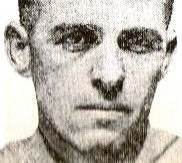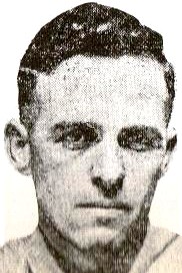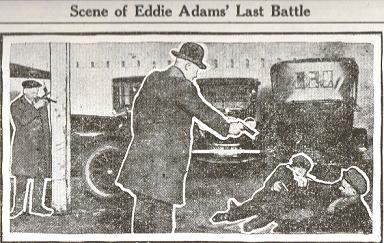Early life
Edward J. "Eddie" Adams was born in 1887 on a farm in Hutchinson, Kansas as W .J. Wallace. His father died when he was young, and his mother remarried, setting the stage for a lifetime of psychological problems. Eddie had a strong disdain for his stepfather, as well as for physical labor.
He learned the barber trade and moved to Wichita, Kansas in the early 1900s. There he met John Callahan and quickly became involved in bootlegging, petty robberies, and car theft.
Adams was a charismatic fellow who attracted a long line of criminal hangers-on and loose ladies. His wife left him after growing weary of his illegal activities and infidelities.
He soon formed his own gang and began committing bank and train robberies throughout Kansas, Missouri and Iowa, eventually earning the reputation as the premier bandit in the Midwest by the early days of Prohibition.
Murder & Kansas City
In 1920, through Callahan, Adams formed a partnership with outlaw brothers Ray and Walter Majors and, on September 5, attempted a daylight robbery against a notorious Kansas City gambling den on Grand Avenue owned by Harry Trusdell.
However, a shootout between the bandits and tough employees of the illegal casino would result in the death of gambler Frank Gardner and the eventual capture of the gang by police.
Identified as the gunman in the tough gambler's death, Adams was sentenced to life imprisonment in February 1921. His partners, the Major brothers, received lesser sentences by agreeing to plea guilty to robbery, and were both sentenced to only five years imprisonment. Both brothers would eventually die behind bars. A third Major brother involved in the botched robbery attempt, Dudley, would escape from the scene only to be later arrested and serve time in the Delaware penitentiary.
Midwest crime spree
While being transported to the Missouri State Prison in Jefferson City, Missouri, Adams escaped custody after jumping off the train and within several days joined Julius Finney in the robbery of a bank and general store in Cullison, Kansas on February 11, 1921.
He was captured near Garden Plain by a posse six days later after wrecking a stolen car under a bridge. Convicted of bank robbery, Adams was sentenced to serve 10 to 30 years at the Kansas State Prison in Lansing, in addition to his life sentence in Missouri for murder.
On August 13, Adams once again successfully escaped imprisonment after sabotaging the prison power plant and scaling the Lansing's prison walls during the night along with inmates Frank Foster, George Weisberger and D.C. Brown. The driver of the getaway car was Billy Fintelman, a World War I veteran gone bad.
With the exception of Brown (who was recaptured days later) the fugitives would elude capture from state authorities and eventually formed what would become the newest incarnation of the Adams Gang.
By September of that year, joined by Fintelman, the gang robbed around $10,000 from banks in Rose Hill and Haysville, Kansas. During the Haysville robbery, Adams pistol-whipped 82-year-old James Krievell for no apparent reason, who later died of a fractured skull.
On October 8, police attempted to trap the gang near Anoly, Kansas, however the gang managed to escape after a gunfight which left Deputy Benjamin Fisher wounded. The gang was spotted eleven days later after stealing $500 in silver from a bank in Osceola, Iowa and, following another attempt by a posse to apprehend the gang near Murrey, killed C.J. Jones before escaping in a stolen car owned by Sheriff E.J. West.
Heading for Wichita, the gang's crime spree continued robbing 11 stores in Muscotah, Kansas and abducting and later robbing two motorcycle officers outside Wichita, where their motorcycles were set on fire.
Back in Wichita, on November 5, 1921, Adams shot and killed Patrolman A.L. Young in cold blood while Young was on duty. The motive behind the killing was said to be a mutual love interest who had chosen the company of the officer over the outlaw.
The gang then committed their most successful robbery with the theft of $35,000 after robbing a Santa Fe express train near Ottawa, Kansas.
Downfall
On the evening of November 20, Adams, along with Foster, Nellie Miles (a local madam and long-time friend of Adams'), George J. McFarland (a local thug and bootlegger) and two alleged prostitutes, were joyriding around Wichita. Another car carrying Fintelman, his wife, Weisberger, P.D. Orcutt, and two unnamed ladies, followed at high speeds.
Two motorcycle policeman pulled over the vehicle carrying Adams when a shot came from the vehicle - it is unknown whether the shot was fired by Adams or Foster - killing patrolman Robert Fitzpatrick. The outlaws sped away, released the women, and fled south into Cowley County.
Later that night the trio ran out of gas and stopped at a farm, where Adams attempted to steal a vehicle from farmer George Oldham. When Oldham resisted, Adams shot and killed him. Adams and Foster took the car, while McFarland ran away alone into the night. The duo returned to Wichita in the stolen car.
The next day, Adams and Billy Fintelman went to McFarland's house to look for him, only to find two officers waiting. Adams shot officer Ray Casner non-fatally while the other policeman hid under a bed. Adams once again escaped.
He hid out until the funeral of fallen officer Fitzpatrick on November 22, where he assumed the bulk of the police force would be present. He had planned to rent a car to leave town for good, but the proprietor of the garage recognized him and contacted police.
Three officers arrived on the scene. Adams shot at them, fatally wounding detective Charles Hoffman who pulled the gunman to the ground. Officer Charles Bowman was also hit by gunfire. D.C. Stuckey, hiding behind a pillar, shot Adams three times and killed him.
Eddie Adams' body was publicly displayed in the City Undertaking Parlor in a grisly celebration of the end of a reign of terror. More than 9,000 people viewed the slain outlaw.
In the end, 18 people were arrested as accomplices and hangers-on of Adams. Four were sent to the Kansas Penitentiary, Frank Foster for life.
Adams, dead at age 34, was attributed with seven murders, including three Wichita policemen, in just a little over 14 month's time. He wounded at least a dozen others.
References
-
Newton, Michael. Encyclopedia of Robbers, Heists, and Capers. New York: Facts On File Inc., 2002.
-
Wellman, Paul. A Dynasty of Western Outlaws. New York: Bonanza Books, 1961.
-
The Wichita Eagle Beacon. The First One Hundred Years. Wichita: Eagle Beacon Publishing Co., 1972, page 49.



